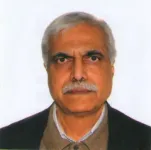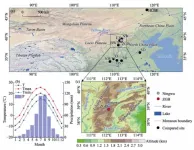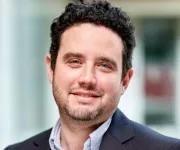(Press-News.org) NEW YORK, NY (March 15, 2024)--Compared to adults, newborns are highly susceptible to infections and these infections can cause serious health complications and even death.
One factor known to affect a newborn’s response to infection is a condition called neonatal neutropenia, in which the infant fails to make enough neutrophils, the immune system’s first responders. What underlies this immune deficiency, which greatly increases a newborn’s susceptibility to infection, is largely unknown, leaving clinicians with little understanding of how to prevent or treat it.
A new study of mice by Columbia University researchers now suggests that many cases of neonatal neutropenia may originate from suppression of the fetus’s blood-forming stem cells, a natural maternal mechanism that protects the placenta from inflammation but may leave newborns vulnerable to infection if not turned off after birth.
“We still have much to learn about neonatal neutropenia, but this is an encouraging step forward in developing new treatments. Our findings tell us that it may be more productive to counteract maternal factors that suppress fetal and neonatal hematopoietic stem cells, instead of trying to directly boost the output of these cells,” says study leader Emmanuelle Passegué, PhD, Alumni Professor of Genetics & Development at the Vagelos College of Physicians and Surgeons and director of the Columbia Stem Cell Initiative at Columbia University.
The clinical challenge
Infants with neonatal neutropenia can develop early-onset sepsis, a life-threatening infection, in the first 72 hours of life.
“Early sepsis is a big problem in full-term infants, but it’s even more dangerous for preterm infants and mortality for these infants is very high,” says first author Amélie Collins, MD, PhD, assistant professor of pediatrics and a neonatologist who treats these hospitalized infants.
Doctors use broad-spectrum antibiotics to treat infants with early-onset sepsis, but antibiotics aren’t always enough and often produce other complications. “A treatment that boosts these infants’ immune system could have a big impact,” Collins says.
The prevailing theory of neonatal neutropenia is that fetuses and neonates with the condition lack the regenerative capacity to produce large numbers of neutrophils to fight infection.
“But what that actually means from a mechanistic standpoint has been unknown,” Collins says. “Perinatal hematopoiesis has been an understudied area of biology.”
Experiments and results
To understand how neutropenia develops in infants, Collins and Passegué used mouse models to investigate how fetal and neonatal hematopoietic stem cells respond to infection.
Adults with infections usually rely on emergency myelopoeisis, a rapid-response mechanism of hematopoietic stem cells that generates large numbers of immune cells, including neutrophils.
Collins and Passegué found that although emergency myelopoeisis becomes functional early in fetal development—the fetus’s hematopoietic stem cells are capable of making neutrophils—the fetus does not turn it on.
That suggested an external factor suppresses fetal myelopoeisis, so the researchers then searched for and found a maternal factor—interleukin 10 or IL-10—that prevents emergency myelopoiesis from being activated during fetal development. Collins and Passegué found that absence of IL-10 can restore emergency myelopoiesis in the fetus and boost neonatal neutrophil production in a manner that is likely to have important clinical benefits.
“This is the key translational advance of our study,” says Collins. “Now that we know fetal and neonatal stem cells can produce neutrophils and we’ve identified IL-10 as one of the factors that suppresses emergency myelopoiesis, we should be able to understand the mechanism and find places where we can intervene.”
Potential impact and future directions
The discovery was also made possible with a second mouse model developed by the researchers that allowed them to track what happens in mouse pups after they’re born (because removing IL-10 comes at the cost of fetal demise in infected pregnant mice).
This second model showed that newborn pups can engage emergency myelopoiesis pathways after they are born and will be crucial for future studies.
“We are now able to learn more about how maternal IL-10 suppresses fetal hematopoietic stem cells and what signals remove the restraints after birth to turn these exciting findings into an effective therapy,” says Passegué.
More information
The study is titled “Maternal inflammation regulates fetal emergency myelopoiesis.”
The other contributors (all from Columbia University) are James W. Swann, Melissa A. Proven, Chandani M. Patel, Carl A. Mitchell, Monica Kasbekar, and Paul V. Dellorusso.
END
Why some newborns develop severe infections
2024-03-15
ELSE PRESS RELEASES FROM THIS DATE:
Protein fragments ID two new “extremophile” microbes—and may help find alien life
2024-03-15
Perfectly adapted microorganisms live in extreme environments from deep-sea trenches to mountaintops. Learning more about how these extremophiles survive in hostile conditions could inform scientists about life on Earth and potential life on other planets. In ACS’ Journal of Proteome Research, researchers detail a method for more accurate extremophile identification based on protein fragments instead of genetic material. The study identified two new hardy bacteria from high-altitude lakes in Chile — an ...
Plasma oscillations propel breakthroughs in fusion energy
2024-03-15
Most people know about solids, liquids, and gases as the main three states of matter, but a fourth state of matter exists as well. Plasma—also known as ionized gas—is the most abundant, observable form of matter in our universe, found in the sun and other celestial bodies.
Creating the hot mix of freely moving electrons and ions that compose a plasma often requires extreme pressures or temperatures. In these extreme conditions, researchers continue to uncover the unexpected ways that plasma can move and evolve. By better understanding the motion of plasma, scientists gain valuable insights into solar physics, astrophysics, ...
Specialized nursing facility clinicians improve end-of-life care
2024-03-15
Specialized nursing facility clinicians, or SNFists, may decrease the likelihood of nursing home residents experiencing stressful hospitalizations and improve the quality of life in their last days, according to researchers from Weill Cornell Medicine.
The paper, published in JAMA Network Open on Mar. 15, examined how SNFists uniquely impacted the care of nursing home residents in their last 90 days, compared with those cared for by other clinicians. This large-scale study is the first of its kind.
“The literature has described ...
Fatty food before surgery may impair memory in old, young adults
2024-03-15
COLUMBUS, Ohio – Eating fatty food in the days leading up to surgery may prompt a heightened inflammatory response in the brain that interferes for weeks with memory-related cognitive function in older adults – and, new research in animals suggests, even in young adults.
The study, building upon previous research from the same lab at The Ohio State University, also showed that taking a DHA omega-3 fatty acid supplement for a month before the unhealthy eating and surgical procedure prevented the effects on memory linked to both the high-fat diet and the surgery in aged ...
Newly discovered receptor influences gut development in fruit flies
2024-03-15
Adhesion GPCRs belong to the large family of G protein-coupled receptors (GPCRs). There are about 700 variants in humans, which are responsible for sensory impressions, hormonal cycles, controlling the cardiovascular system and more. GPCRs translate stimuli that hit a cell from outside into an intracellular biochemical signal.
The use of the fruit fly as a model animal allows researchers in this field to gain a deep understanding of human diseases, because the animals are genetically very similar to humans. Scientists estimate that around 75 per cent of the genes involved in human diseases ...
New research suggests that our universe has no dark matter
2024-03-15
The current theoretical model for the composition of the universe is that it’s made of ‘normal matter,’ ‘dark energy’ and ‘dark matter.’ A new uOttawa study challenges this.
A University of Ottawa study published today challenges the current model of the universe by showing that, in fact, it has no room for dark matter.
In cosmology, the term “dark matter” describes all that appears not to interact with light or the electromagnetic field, or that can only be explained through gravitational force. We can’t see it, nor do we know what ...
A breakthrough in tiny tool tuning: making microscopic measurements more accurate
2024-03-15
A study introduces a novel method for calibrating the spring constant of FluidFM micropipette cantilevers, crucial for the accurate measurement of forces in microfluidic environments. This method addresses the limitations of current calibration techniques, offering a significant advancement in the field of force microscopy.
Fluidic force microscopy (FluidFM) combines the sensitivity of atomic force microscopy with microfluidics' capabilities, necessitating precise calibration of its cantilevers for reliable data. Traditional methods, however, struggle with the unique internal structure of FluidFM cantilevers, leading to ...
Unlocking the climate secrets of North China with ancient tree rings
2024-03-15
A recent study published in the Journal of Geographical Sciences in December 2023 reveals a novel method for reconstructing historical warm season temperatures in North China. Utilizing the blue intensity (BI) of tree rings of Picea meyeri, researchers have developed a 281-year chronology, offering unprecedented insights into the region’s climatic past.
The escalating public concern over climate warming, due to its significant impacts on society, ecosystems, and the environment, underscores the importance of understanding long-term climatic conditions across different regions. As the limited observational records constrain our comprehensive grasp of climate change, tree-ring data prove ...
Aston University wins funding to improve sustainability in the Philippines
2024-03-15
Funding will prepare three scientists to improve sustainable development in their country
The University has won British Council International Science Partnerships funding of £180,000
The University already has close ties with the sustainability sector in the Philippines.
Aston University is to help tackle sustainability problems in the Philippines by offering training to three of the country’s early career researchers.
The University has won British Council International Science Partnerships funding of £180,000 to host three scientists ...
Revealing nature's secrets from space: satellite data unlocks drought's impact on Southwest China's carbon cycle
2024-03-15
A new study reveals a significant increase in aboveground carbon (AGC) in Southwest China from 2013 to 2021, defying the adverse effects of extreme droughts. This achievement underscores the region's pivotal role as a carbon sink, attributed to extensive ecological projects and innovative remote sensing techniques.
Over the past four decades, Southwest China has been a major carbon sink, significantly mitigating anthropogenic CO2 emissions. However, recent severe droughts, especially from 2009-2013 and in 2022, have drastically reduced its carbon ...






